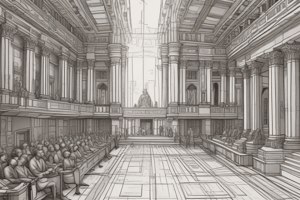Podcast
Questions and Answers
What is the primary goal of policy analysis?
What is the primary goal of policy analysis?
- To identify and compare potential policy options. (correct)
- To promote wishful thinking in policy formation.
- To ensure policies are only created by public officials.
- To discourage public participation in policy making.
Which of the following best describes the artistic aspect of policy analysis?
Which of the following best describes the artistic aspect of policy analysis?
- It focuses on financial feasibility above all else.
- It requires insight, creativity, and imagination. (correct)
- It is governed strictly by legal frameworks.
- It relies solely on quantitative data.
Who are the key stakeholders involved in public policy analyses?
Who are the key stakeholders involved in public policy analyses?
- Only subject matter experts.
- People affected by the policy, subject matter experts, and public officials. (correct)
- Only the general public.
- Only public officials.
What is the first step in conducting a public policy analysis?
What is the first step in conducting a public policy analysis?
What does the Incrementalism policy model emphasize?
What does the Incrementalism policy model emphasize?
Which of the following criteria is NOT typically established in public policy analysis?
Which of the following criteria is NOT typically established in public policy analysis?
What is the primary focus of the Process model of public policy?
What is the primary focus of the Process model of public policy?
In public policy analysis, what does the term 'equity' refer to?
In public policy analysis, what does the term 'equity' refer to?
What does Public Choice Theory primarily assume about individuals in politics?
What does Public Choice Theory primarily assume about individuals in politics?
Which theory suggests that policy is primarily influenced by a ruling elite?
Which theory suggests that policy is primarily influenced by a ruling elite?
What is one of the key components of Rationalism in public policy?
What is one of the key components of Rationalism in public policy?
What is a prerequisite for a problem to become an agenda item?
What is a prerequisite for a problem to become an agenda item?
In the context of game theory, what is the significance of the Prisoners' Dilemma?
In the context of game theory, what is the significance of the Prisoners' Dilemma?
What aspect does Agenda Setting emphasize regarding media's role?
What aspect does Agenda Setting emphasize regarding media's role?
In Elite Theory, which group is positioned at the top of the decision-making pyramid?
In Elite Theory, which group is positioned at the top of the decision-making pyramid?
Which of the following does NOT typically lead to an issue being considered part of the public agenda?
Which of the following does NOT typically lead to an issue being considered part of the public agenda?
Flashcards are hidden until you start studying
Study Notes
Public Policy Analysis
- Policy analysis can be defined as a method for identifying and evaluating potential policy options to find the most effective, efficient, and feasible solution for a given problem.
- It involves understanding government actions, their motivations, and their impact.
- Public policy analysis requires both artistic (insight, creativity) and practical (economic, political, administrative, sociological, and legal knowledge) skills.
The Importance and Participants of Public Policy Analysis
- Policy analysis ensures a comprehensive approach to selecting the best policy option for a given scenario.
- It involves the participation of:
- Individuals impacted by the policy.
- Subject matter experts.
- Public officials and administrators.
The Policy Analysis Process
- The policy analysis process involves the following steps:
- Problem identification: Defining the issue and its scope.
- Policy goal examination: Establishing the desired outcomes of the policy.
- Criteria establishment: Setting standards for evaluating policy options (e.g., equity, legality, effectiveness, costs, benefits, political and social acceptability).
- Alternative identification: Exploring various potential policy solutions.
- Strengths and weaknesses analysis: Evaluating the pros and cons of each alternative.
- Reporting, implementation, monitoring, and evaluation: Sharing the findings, putting the chosen policy into action, tracking its progress, and assessing its effectiveness.
Public Policy Models
- Different perspectives influence how public policies are viewed.
- Institutionalism: Policy as a product of institutions.
- Process: Policy as political activity.
- Incrementalism: Policy as a gradual evolution of past practices.
- Group Theory: Policy as a result of group interactions and power struggles.
- Elite Theory: Policy as the preference of ruling elites.
- Public Choice Theory: Policy as a reflection of individuals striving to maximize their own gains.
- Game Theory: Policy as strategic decision-making in competitive situations.
- Rationalism: Policy as a means to maximize social benefits and minimize costs.
Agenda Setting
- Agenda setting refers to the process of identifying and prioritizing issues that demand public attention and policy action.
- The media plays a crucial role in shaping public perceptions of reality and influencing which issues gain prominence.
- Factors that contribute to an issue becoming a priority on the public agenda include:
- Crisis proportions: The urgency or severity of the issue.
- Particularity: The issue's connection to a broader context.
- Emotive aspects: The issue's potential to evoke public interest or emotional engagement.
- Widespread impact: The issue's effect on a significant portion of the population.
- Fashionability: The issue's alignment with current social trends or popular discourse.
Studying That Suits You
Use AI to generate personalized quizzes and flashcards to suit your learning preferences.




